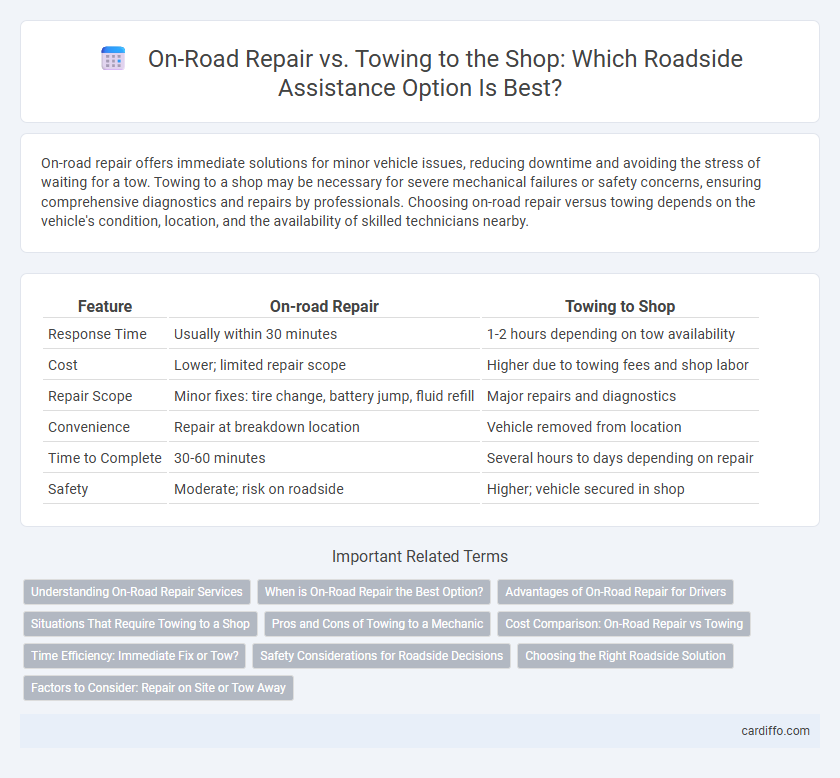On-road repair offers immediate solutions for minor vehicle issues, reducing downtime and avoiding the stress of waiting for a tow. Towing to a shop may be necessary for severe mechanical failures or safety concerns, ensuring comprehensive diagnostics and repairs by professionals. Choosing on-road repair versus towing depends on the vehicle's condition, location, and the availability of skilled technicians nearby.
Table of Comparison
| Feature | On-road Repair | Towing to Shop |
|---|---|---|
| Response Time | Usually within 30 minutes | 1-2 hours depending on tow availability |
| Cost | Lower; limited repair scope | Higher due to towing fees and shop labor |
| Repair Scope | Minor fixes: tire change, battery jump, fluid refill | Major repairs and diagnostics |
| Convenience | Repair at breakdown location | Vehicle removed from location |
| Time to Complete | 30-60 minutes | Several hours to days depending on repair |
| Safety | Moderate; risk on roadside | Higher; vehicle secured in shop |
Understanding On-Road Repair Services
On-road repair services provide immediate mechanical fixes at the vehicle's location, reducing downtime and avoiding the costs associated with towing to a shop. These services typically address minor issues such as battery jump-starts, tire changes, and fluid replenishment, enabling drivers to resume their journeys quickly. Understanding the scope and limitations of on-road repairs helps drivers make informed decisions when faced with breakdowns, balancing convenience and safety.
When is On-Road Repair the Best Option?
On-road repair is the best option when the vehicle issue is minor, such as a flat tire, dead battery, or overheating, allowing for quick fixes without the need for a tow. Choosing on-road repair reduces downtime and avoids the higher costs associated with towing and shop labor fees. This service is ideal for location-based emergencies where immediate assistance can restore vehicle function and ensure safe continuation of the journey.
Advantages of On-Road Repair for Drivers
On-road repair offers drivers immediate vehicle diagnosis and resolution, minimizing downtime and enabling quicker continuation of travel. This method reduces towing costs and prevents potential damage associated with transportation to a repair shop. Access to expert mobile mechanics ensures convenience and efficiency, providing tailored solutions directly at the roadside.
Situations That Require Towing to a Shop
Situations that require towing to a shop typically involve severe mechanical failures such as engine breakdowns, transmission issues, or compromised braking systems that cannot be safely or effectively repaired on the roadside. Complex electrical problems or significant collision damage also necessitate professional diagnostics and repairs at a fully equipped auto repair facility. Towing ensures vehicle safety and prevents further damage when on-road repair is insufficient or unsafe.
Pros and Cons of Towing to a Mechanic
Towing to a mechanic ensures access to specialized diagnostic equipment and expert repairs that on-road fixes may not provide, increasing the likelihood of a thorough and long-lasting solution. However, towing can incur higher costs and longer wait times compared to immediate on-road repairs, potentially leaving drivers stranded longer. This method is preferable for severe mechanical failures or when safety is compromised, offering professional assessment and reducing the risk of further vehicle damage.
Cost Comparison: On-Road Repair vs Towing
On-road repair typically costs between $50 and $150, offering immediate solutions for minor vehicle issues such as battery jumps or flat tire changes, whereas towing fees range from $75 to $125 per mile, often resulting in higher expenses when the repair shop is distant. Choosing on-road repair can significantly reduce overall costs by avoiding additional towing and potential shop labor fees, especially for minor breakdowns. Comparing these expenses highlights that on-road repair is generally more economical for straightforward vehicle issues, while towing is necessary for complex repairs beyond roadside capabilities.
Time Efficiency: Immediate Fix or Tow?
On-road repair offers significant time efficiency by addressing common vehicle issues like flat tires, battery jumps, or minor engine problems immediately at the roadside, minimizing downtime. Towing to a shop can delay vehicle return due to transport and diagnostic procedures but ensures comprehensive repairs for complex mechanical failures. Choosing on-road repair maximizes immediate vehicle usability, while towing prioritizes thorough service quality for lasting reliability.
Safety Considerations for Roadside Decisions
On-road repair prioritizes immediate safety by addressing minor vehicle issues without moving the car, reducing the risk of accidents on busy roads. Towing to a shop becomes essential when repairs require specialized equipment or pose hazards unsuitable for roadside conditions. Choosing between on-road repair and towing depends on factors such as traffic density, weather conditions, and the severity of the vehicle malfunction to ensure the driver, passengers, and roadside workers remain protected.
Choosing the Right Roadside Solution
Choosing the right roadside solution depends on the severity and type of vehicle issue; on-road repair is ideal for minor problems like flat tires or battery jumps, providing quick and cost-effective service. Towing to a shop is necessary for complex mechanical failures or safety concerns, ensuring professional diagnostics and comprehensive repairs. Prompt assessment by trained roadside technicians helps determine the most efficient and reliable option, minimizing downtime and further vehicle damage.
Factors to Consider: Repair on Site or Tow Away
Assessing vehicle damage severity and safety risks determines whether on-road repair or towing to a shop is preferable. Availability of specialized tools and mechanic expertise on-site influences the feasibility of immediate repairs versus transport. Time constraints, traffic conditions, and cost implications also play critical roles in deciding the optimal roadside assistance approach.
On-road Repair vs Towing to Shop Infographic

 cardiffo.com
cardiffo.com